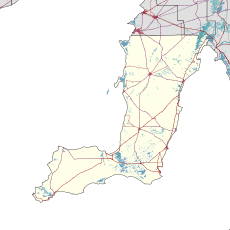Point Pearce, South Australia facts for kids
Quick facts for kids Point PearceSouth Australia |
|
|---|---|
| Established | 1868 |
| Postcode(s) | 5573 |
| Elevation | 16 m (52 ft) |
| Location | |
| LGA(s) | Yorke Peninsula Council |
| State electorate(s) | Narungga |
| Federal Division(s) | Grey |
Point Pearce, also known as Point Pierce, is a town in the Australian state of South Australia. It is located on the Yorke Peninsula Council land. The town is about 194 kilometres (121 miles) north-west of Adelaide, the state's capital city.
Point Pearce is famous for the mission that was set up there in the late 1800s. This mission was for Aboriginal people. The local Narungga people originally called this place Bookooyanna.
The mission started as Point Pearce Mission Station in 1868. Later, in 1915, the state government took over. It then became the Point Pearce Aboriginal Station, which was a special Aboriginal reserve. In 1972, the land was given back to the Point Pearce Community Council. This happened under a law called the Aboriginal Lands Trust Act 1966.
Contents
A Look at Point Pearce's Past
Point Pearce was one of several missions created in South Australia in the late 1800s. These missions included places like Poonindie and Point McLeay. They were some of the few places where Aboriginal people, who had lost their land, could find a home. The main goal of these missions was to share Christian beliefs.
How Point Pearce Began
After Adelaide was founded in 1836, settlers started moving into the Yorke Peninsula. The Narungga people lived a nomadic lifestyle, moving around the land. The British idea of owning land did not fit with their way of life. This led to Aboriginal people slowly losing their traditional lands.
In 1868, the Point Pearce Aboriginal Mission was started. It was set up by a missionary named Reverend W. Julius Kuhn from the Moravian Church.
A piece of land, about 600 acres (240 hectares), was given for the settlement on February 2, 1868. This place was known as Bookooyanna. The Point Pearce Mission Station was run by a committee. At first, about 70 Narungga people came to live there.
Changes Over Time
In 1874, the reserve land was made bigger. It grew by another 12 square miles (31 square kilometres) and included Wardang Island. By 1878, the mission was mostly able to support itself. It earned money from selling wool and wheat.
In 1894, families from the Poonindie Mission, which had closed, moved to Point Pearce. The mission had a school. A separate school building was built in 1906. Many children, including those of mixed European and Chinese heritage, attended the school.
During World War I, Aboriginal men from Point McLeay and Point Pearce were among the first in South Australia to join the army.
Government Takes Control
In 1913, a special group called the Royal Commission on the Aborigines looked into how Aboriginal people were treated. Because of their findings, the South Australian government took over the mission in 1915. It then became known as the Point Pearce Aboriginal Station. This was a special Aboriginal reserve.
One of the recommendations was that the government should become the legal guardian of all Aboriginal children once they turned 10. This meant the government could decide where these children would live. Seven years later, a law called the Aborigines (Training of Children) Act 1923 was passed. This law allowed Indigenous children to be "trained" in special places so they could go out and work.
Point Pearce is mentioned in the Bringing Them Home report. This report talks about the Stolen Generations. These were Indigenous children who were sadly taken away from their families by force.
Community Takes Control
In 1972, the ownership of Point Pearce was given to the Point Pearce Community Council. This was done under the Aboriginal Lands Trust Act 1966. Many of the original buildings from the mission are still standing today.
Where is Point Pearce?
Point Pearce is located about 10 kilometres (6 miles) north along the coast from Port Victoria. Point Pearce and Wardang Island help protect the small port, which is used for fishing and recreation.
Famous People from Point Pearce
Many important people have connections to Point Pearce:
- Ivaritji (around 1849 – 1929) was a Kaurna elder. She was the last known speaker of the Kaurna language. She lived in Point Pearce for many years.
- Gladys Elphick (1904 – 1988) was the first president of the Council of Aboriginal Women of South Australia. She grew up in Point Pearce.
- Lewis O'Brien (born 1930) is a Kaurna elder. He was born in Point Pearce.
- Alitya Rigney (1942 – 2017) was a Kaurna elder and a scholar. She worked hard to help bring back the Kaurna language. She was born in Point Pearce.
- Tauto Sansbury (around 1949 – 2019) was an Indigenous activist. He was born in Point Pearce.
- Natasha Wanganeen (born 1984) is an AFI award-winning actor. She grew up in Point Pearce.


